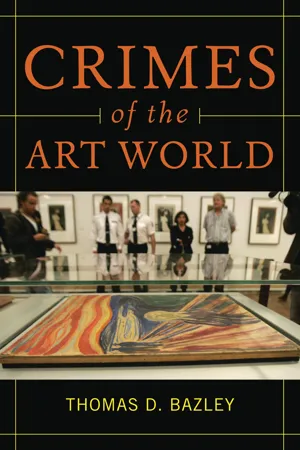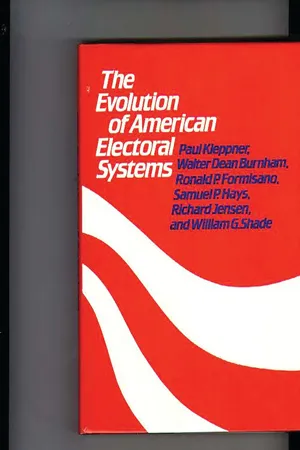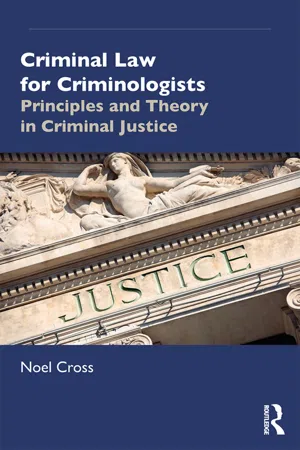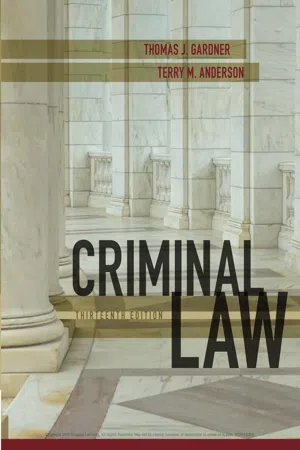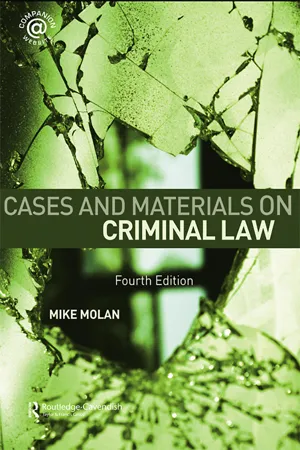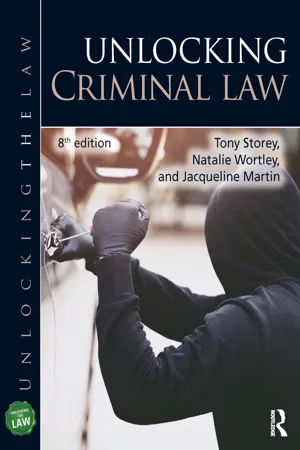Law
Burglary
Burglary is the unlawful entry into a building or property with the intent to commit a crime, typically theft. It is considered a serious criminal offense and is often associated with theft, vandalism, or other illegal activities. The specific laws and penalties for burglary vary by jurisdiction, but it is generally viewed as a violation of property rights and personal security.
Written by Perlego with AI-assistance
Related key terms
1 of 5
10 Key excerpts on "Burglary"
- No longer available |Learn more
- Kären Hess, Christine Hess Orthmann, Henry Cho, , Kären Hess, Christine Hess Orthmann, Henry Cho(Authors)
- 2016(Publication Date)
- Cengage Learning EMEA(Publisher)
Investigators found many of the stolen items at the man’s house and, through additional intelligence, were able to track down more of the stolen prop-erty in other locations, some of which were across state lines. Because of this last development, potential Federal Interstate Commerce charges may be added to Burglary charges the man already faces (MacDonald, 2015). wavebreakmedia/Shutterstock.com Copyright 2017 Cengage Learning. All Rights Reserved. May not be copied, scanned, or duplicated, in whole or in part. Due to electronic rights, some third party content may be suppressed from the eBook and/or eChapter(s). Editorial review has deemed that any suppressed content does not materially affect the overall learning experience. Cengage Learning reserves the right to remove additional content at any time if subsequent rights restrictions require it. SECTION 4 Investigating Crimes Against Property 434 The word burglar comes from the German words burg , meaning “house,” and laron , meaning “thief,” thus the meaning “house thief.” The Federal Bureau of Investigation’s (FBI) Uniform Crime Reports (UCR) defines Burglary as “the unlawful entry of a structure to commit a felony or theft, even though no force was used to gain entry.” All such attempts also count as burglaries. The common-law definition of Burglary (originating in 16th-century England) required that the breaking and entering be committed during the nighttime or “between sunset and sunrise.” Many changes have been made in Burglary statutes since that time, including eliminating the requirement that it occur at night. LO1 Burglary is the unlawful entry of a structure to commit a crime. Burglary is reported by frequency and by the value of the property stolen and recovered. This is because many burglaries yield low losses, although a single Burglary can yield a high loss. - eBook - PDF
- Charles P. Nemeth(Author)
- 2011(Publication Date)
- Routledge(Publisher)
One can steal, but also rob and rape within the domicile. Another aspect that prompts so much confusion involves the dual intents that accompany the typical Burglary prosecution. Initially, the perpetrator intends to break and enter a domicile or other qualified structure. At the same time, this perpetrator must intend some other felony as part of the master plan of invasion. Which intent controls? Are both intents needed? Or does each have the same weight? What if the prosecution fails to prove one type of intent? In this sense, Burglary is often labeled a crime of dual intents. 1 Add to this the incredibly creative and energized defenses posed by the accused in the crimi-nal courtroom and you have a recipe for befuddlement. Despite these complexities, the basic elements of Burglary are quite consistent among most American jurisdictions. The Breaking and Entry What causes the general citizenry to be so outraged at the act of Burglary is its invasiveness. Few acts in the criminal arena, outside of personal offenses, raise such alarm and for good cause. A few jurisdictions have divided up the Burglary elements into distinct offenses. For example, Arkansas categorizes and defines the distinct offense of “Breaking or Entering.” (a) A person commits the offense of breaking or entering if for the purpose of committing a theft or felony he or she breaks or enters into any: (1) Building, structure, or vehicle; (2) Vault, safe, cash register, safety deposit box, or money depository; (3) Money vending machine, coin-operated amusement machine, vending machine, or product dispenser; - eBook - PDF
- Thomas D. Bazley Ph.D.(Author)
- 2010(Publication Date)
- Praeger(Publisher)
To clas- • sify an offense as a Burglary, the use of force to gain entry need not have oc- curred. There are three sub-classifications for Burglary: forcible entry, unlawful entry where no force is used, and attempted forcible entry. The UCR definition of “structure” includes, for example, apartment, barn, house trailer or house- boat when used as a permanent dwelling, office, railroad car (but not automo- bile), stable, and vessel (i.e., ship). Robbery—the taking or attempting to take anything of value from the care, cus- • tody, or control of a person or persons by force or threat of force or violence and/or by putting the victim in fear. 1 These crimes, of course, are not unique to the United States, but again they may be defined somewhat differently from country to country. While it would be too cumbersome (and perhaps unnecessary) to examine the definitions for these types of misconduct on a country by country basis, one way to gain a consolidated international perspective is to consider the definitions used by the United Nations (U.N.) in collecting data on world- wide crime trends. These definitions are as follows: Theft—may be understood to mean the removal of property without the prop- • erty owner’s consent and excludes Burglary and housebreaking as well as theft of a motor vehicle. Burglary—may be understood to mean unlawful entry into someone else’s • premises with the intention to commit a crime. Robbery—may be understood to mean the theft of property from a person, • overcoming resistance by force or threat of force. 2 Art Theft 23 As may be observed, aside from variations in verbiage, the only sig- nificant difference between the UCR and U.N. definitions is that the latter replaces the term larceny with theft, although the respective descriptions of the misconduct involved are essentially the same. - eBook - PDF
- Michael Birzer, Cliff Roberson, Michael Birzer, Cliff Roberson(Authors)
- 2018(Publication Date)
- Routledge(Publisher)
Larceny and Burglary crimes are catego-rized together under the umbrella term of property crimes for statistical purposes. Law enforcement agencies organize investigative units or squads in this same fashion to inves-tigate property crimes. This allows for improved communication among squad members through sharing of information gathered and assisting one another in case investigations. Investigating larceny and Burglary can be satisfying with the proper training, knowledge, and mindset. This domain of investigations can offer a wonderful opportunity for investi-gators to learn the techniques and develop the skills necessary to solve major crimes. LARCENY The crime of larceny is the same as theft. Many jurisdictions list one or the other as offenses. Each state has different levels of classification based on specific dollar amounts to distin-guish between a felony and a misdemeanor offense. By definition, the act of larceny or theft is the unlawful taking of property from another or exerting control over the property by possessing it without the authority to do so. Examples of these offenses include shoplift-ing and pocket picking, and acts of larceny or theft are generally associated with the act of Burglary. Variations of laws enacted by different state, counties, or municipalities may specifically address the theft of gas, theft of services, and theft by deception. Motor vehicle theft has its own classification and is separate from general larceny/theft in most agencies. Burglary The crime of Burglary consists of unlawfully entering or attempting to enter the property of another with the intent to commit a felony or larceny with or without force. The property can be a fixed structure, vehicle, or boat. For charging purposes, no distinction is made among these structure types, although in many jurisdictions this information is usually designated on the original offense reports filed by officers. - eBook - PDF
- Raneta Mack(Author)
- 1999(Publication Date)
- Greenwood(Publisher)
For example, the force or threat of force might be conveyed to the victim via a telephone conversation, a letter, or a third party. Additionally, the force doesn’t have to take the form of a threat to the victim’s personal safety. It could, for instance, be a threat to the victim’s relatives or a threat to harm the victim’s reputation. Once again, the force or threat of force must be used to compel the victim to exchange something of value, although the force or threat does not have to be immediate or in the presence of the victim as long as it is somehow conveyed to the victim. Burglary At common law, the crime of Burglary required breaking and entering into the dwelling of another at night with the intent to commit a felony once inside the dwelling. Since this definition was much too specific to cover all of the factual variations surrounding the crime of Burglary, the definition was gradually expanded to allow for different degrees of Burglary depending upon the circumstances of the crime. Breaking and Entering The crime of Burglary requires that the defendant unlawfully break and enter onto the premises. While the term breaking and entering can encompass the typical breaking (or picking) of a lock to gain entry, it can also include more subtle forms of breaking such as bypassing or fraudulently obtaining a security code in order to unlawfully gain entry. Additionally, certain circumstances can constitute breaking and entering simply because the defendant entered or remained on the premises without the consent of Page 118 the owner. For example, entering the unlocked or open door of a residence can be considered breaking and entering even though the defendant technically did not have to break into the premises. The mere fact of entering without permission is sufficient to constitute breaking and entering. - eBook - ePub
Criminal Law for Criminologists
Principles and Theory in Criminal Justice
- Noel Cross(Author)
- 2020(Publication Date)
- Routledge(Publisher)
‘The Fraud Act 2006 effectively criminalises lying because it does not require loss to the victim, and as such is too wide in terms of criminalisation’. Discuss this statement.BurglaryStatutory definitionThe Theft Act 1968 defines several types of Burglary. Under s.9(1)(a), D is guilty of Burglary if they enter a building or part of building as a trespasser and with intent to commit theft, grievous bodily harm (GBH), or criminal damage. Under s.9(1)(b), D is guilty of Burglary if, after entering a building or a part of a building as a trespasser, they commit theft, attempted theft, GBH, or attempted GBH while inside. S.26 of the Criminal Justice Act 1991 amended s.9 to distinguish between domestic Burglary, committed in buildings where people live, and non-domestic Burglary. It is a question of fact in courts as to whether property that has been burgled is domestic or not (Flack [2013] EWCA Crim 115). S.10 of the Theft Act 1968 defines a more serious form of Burglary, aggravated Burglary, as a Burglary committed while D has a firearm, imitation firearm, any offensive weapon, or any explosive with him at the time. Both the s.9(1)(a) and the s.9(1)(b) forms of Burglary can be committed in this aggravated form.Actus reus – entryIn both forms of Burglary, the prosecution has to prove that D entered the building as a trespasser. The question here is how far D has to go before they have committed an ‘entry’ into the building. Collins [1973] QB 100 stated that D had to have made an ‘effective and substantial entry’ into the building as a trespasser, and that this was a question for magistrates or juries to decide on the facts of each case. However, Brown [1985] Crim LR 212 decided that entry only had to be effective, and not substantial, without actually overruling Collins. Ryan [1996] Crim LR 320 again stated that D’s entry only has to be effective, and could be effective even if not all of D’s body had actually entered the building.Actus reus – trespassTrespassing, in civil law terms, means being on someone else’s property or land without their permission. Questions about the actus reus of trespass in Burglary cases have centred around what happens when D has some level of permission to be in a particular building but then goes further in trespassing terms than they are allowed to. Jones and Smith [1976] 3 All ER 54 shows that where D enters a building where they have general permission to be, but enters knowing that they are going further than they are allowed to go in the building, or entered being subjectively reckless about whether they were doing this, then D is trespassing. Walkington [1979] 2 All ER 716 states that it is possible to trespass in a part - eBook - PDF
- Joel Samaha(Author)
- 2016(Publication Date)
- Cengage Learning EMEA(Publisher)
Due to electronic rights, some third party content may be suppressed from the eBook and/or eChapter(s). Editorial review has deemed that any suppressed content does not materially affect the overall learning experience. Cengage Learning reserves the right to remove additional content at any time if subsequent rights restrictions require it. 462 CHAPTER 11 • CRIMES AGAINST PROPERTY Lewis means that a house is the material thing worth money, but a home is the haven of refuge where we seek security and privacy from the outside world. Burglary consists of breaking and entering a building with intent to commit a crime inside the building. The elements of common law Burglary from which our modern law of Burglary descends included: a. Breaking and entering (actus reus) b. The dwelling of another (circumstance element) c. In the nighttime (circumstance element) d. With the intent to commit a felony inside (mens rea) Modern Burglary has outgrown its common law origin of protecting only homes. Now, you can “burglarize” all kinds of structures, even vehicles, at any time of the day or night. Definitions such as “any structure” or “any building” are common in many statutes. One writer (Note 1951, 411) who surveyed the subject concluded that any structure with “four walls and a roof” was included. Here’s California’s list of “structures” you can burglarize: any house, room, apartment, tenement, shop, warehouse, store, mill, barn, stable, out- house or other building, tent, vessel, floating home, locked or sealed cargo container, whether or not mounted on a vehicle, trailer coach, any house car, inhabited camper, vehicle, when the doors are locked, aircraft, or mine or any underground portion thereof. (California Penal Code 2015, § 459) Let’s look at the elements needed to prove Burglary and then the degrees of Burglary. Burglary ACTUS REUS Until the 1900s, Burglary actus reus consisted of two actions—breaking and entering. - eBook - PDF
- Thomas Gardner, Terry Anderson(Authors)
- 2017(Publication Date)
- Cengage Learning EMEA(Publisher)
Proof of Burglary When Other Crimes Are Committed As a trespass offense, Burglary is most often committed by a defendant who steals or who has an intent to steal. Criminals, however, enter private premises for criminal purposes other than to steal. Offenders have entered the premises of others with intent to commit rape, arson, or other serious felonies. In the 2008 case of State v. Jacobs, 43 the court affirmed a conviction of Burglary, holding that evidence showed the defendant entered the victim’s hotel room with the intent to assault her and steal her purse. The charge of Burglary is sometimes one of multiple serious charges against a defendant who went on a criminal rampage in a private home or business place. In the Jacobs case discussed above prosecutors charged the defendant with both forcible rape and aggravated Burglary, based on the unlawful entry and resulting battery of the victim, which increased simple Burglary to aggravated Burglary under Copyright 2018 Cengage Learning. All Rights Reserved. May not be copied, scanned, or duplicated, in whole or in part. WCN 02-300 - eBook - ePub
Cases & Materials on Criminal Law
Fourth Edition
- Mike Molan(Author)
- 2009(Publication Date)
- Routledge-Cavendish(Publisher)
R v Hale (1978) 68 Cr App R 415 at 418 and continued:] Nor do we think that in a given criminal enterprise involving theft there can necessarily be only one ‘appropriation’ within s 3(1) of the Theft Act 1968. It seems to us that the question of whether, when and by whom there has been an appropriation of property has always to be determined by the jury having regard to the circumstances of the case. The length of time involved, the manner in which it came about and the number of people who can properly be said to have taken part in an appropriation will vary according to those circumstances. In a case of Burglary of a dwelling-house and before any property is removed from it, it may consist of a continuing process and involve either a single appropriation by one or more persons or a number of appropriations of the property in the house by several persons at different times during the same incident. If this were not a correct exposition of the law of appropriation, startling and disturbing consequences could arise out of the presence of two or more trespassers in a dwelling-house.Thus a person who may have more the appearance of a handler than the thief can nevertheless still be convicted of theft, and thus of Burglary, if the jury are satisfied that with the requisite dishonest intent he appropriated, or took part in the appropriation, of another person’s goods.Comments and Questions
- For D to have entered a building for the purposes of Burglary it is not necessary that his entire body should be within the building. In R v Brown [1985] Crim LR 212, the appellant was caught standing on the pavement leaning in through a broken shop window to take goods on display. It was held that this satisfied the requirements of a ‘substantial and effective’ entry for the purposes of the offence.
- In R v Collins (above) the Court of Appeal rejected the notion that only the complainant’s parents could give others permission to enter the family home, yet in R v Jones and Smith the court ignored the father’s evidence that his own son would never be a trespasser in his house. Are these approaches reconcilable?
11.4 Trespass with Intent to Commit a Sexual Offence
In July 2000 the Home Office published its review of sexual offences, Setting the Boundaries: Reforming the Law on Sex Offences - eBook - ePub
- Tony Storey, Natalie Wortley, Jacqueline Martin(Authors)
- 2022(Publication Date)
- Routledge(Publisher)
Cate, who is addicted to heroin, goes to her parents’ house. She does not have permission to enter the house and has no key, but she tries the back door and finds it unlocked. She walks inside planning to ask her parents if she can borrow some money. Her parents are out but she sees her father’s wallet, which she takes. She then hears the front door being opened and realises that her mother has come home. Cate pushes past her mother and leaves the house with the money.Identify the conduct that may give rise to an offence:- C enters the house without permission then steals a wallet, so may be liable for Burglary under s 9(1)(b).
- C uses force to escape with the money so may be liable for robbery.
Define Burglary:- State the definition of Burglary in s 9 – distinguish between s 9(1)(a) Burglary and s 9(1)(b) Burglary.
Entry:- Explain that it is for the jury to decide whether a person has entered premises (Ryan).
- C entered her parents’ house when she walked inside.
Building or part of a building:- Explain that a ‘building’ must have a degree of permanence (B and S v Leathley; Norfolk Constabulary v Seekings and Gould).
- The house is clearly a building.
Trespasser:- Explain that a trespasser is someone who enters without permission, knowing or being reckless as to the fact they do not have permission (Collins).
- C know she does not have permission to be in the house as she does not have a key.
- Explain that C would not liable for Burglary under s 9(1)(a) as she did not intend to commit any of the ulterior offences in s 9(2) when she entered the house.
s9(1)(b):- Explain that to be liable under s 9(1)(b), D must steal or attempt to steal, or inflict/attempt to inflict GBH.
- State the definition of theft in s 1 TA 1968.
Index pages curate the most relevant extracts from our library of academic textbooks. They’ve been created using an in-house natural language model (NLM), each adding context and meaning to key research topics.


